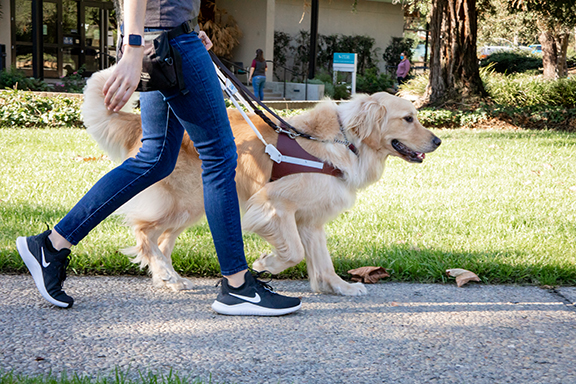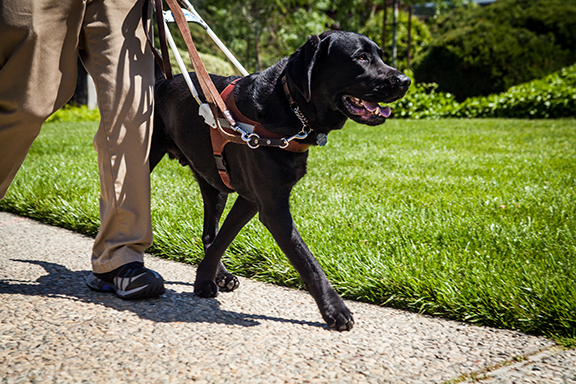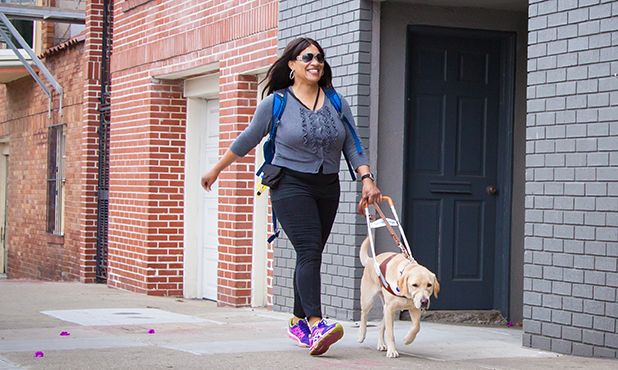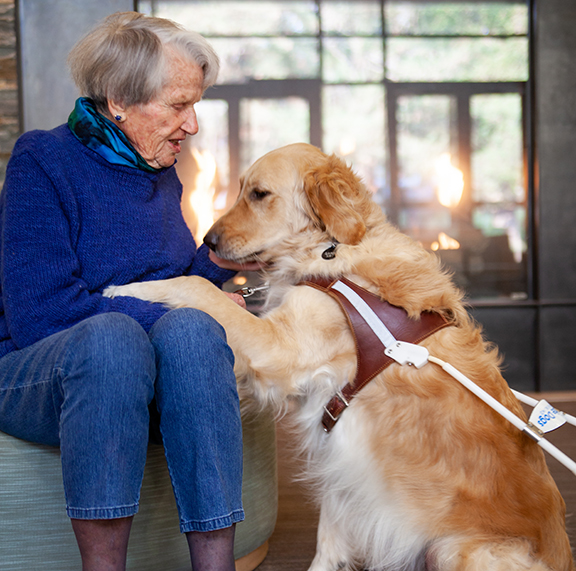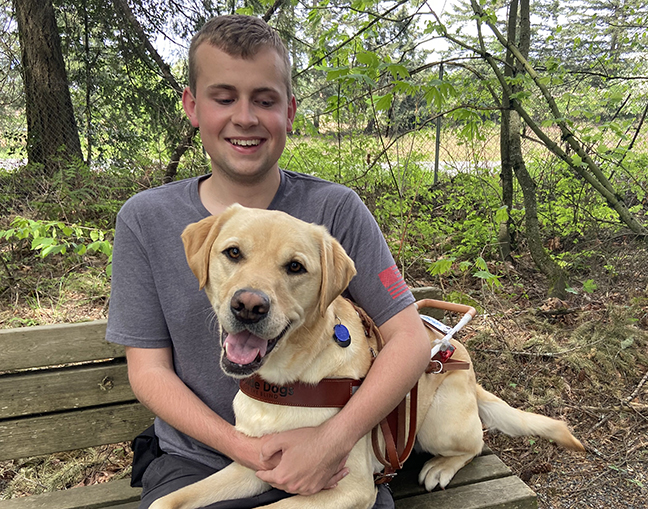Focus group and interview participants emphasized the role of family members, friends, and other close loved ones in shaping the decision to get a guide dog and, sometimes, the subsequent relationship with the dog. In the best cases, family members provide support and guidance. However, there are times when family members’ preferences regarding guide dogs do not align with the preferences of the individual who is blind or has low vision. As described in our study, families can sometimes either pressure an individual into getting a guide dog, or they may oppose the decision to bring a guide dog into the home or misunderstand the guide dog’s role. Family reluctance may make it difficult for some individuals to go through with receiving a guide dog even when they are very motivated to do so. Furthermore, even when families accept the guide dog, misunderstanding of the guide dog’s role can cause challenges if family members unintentionally interfere with the guide dog’s work. One participant noted the struggles of dealing with family members’ misunderstanding or interference, saying,
“I have two rules for my family: You better keep up with my 36-inch legs. And don’t ask me silly questions.”
Cultural factors can also impact attitudes toward guide dogs. Some of our focus group and interview participants noted that certain cultural groups may have beliefs about dogs or about family and personal roles that may conflict with the guide dog lifestyle. For example, some Latino/a or Hispanic participants described their culture as focused on self-reliance and family interdependence. These participants felt that their family members did not always understand or appreciate the purpose of a guide dog in assisting them. Furthermore, the presence of a dog in one’s home or in public spaces is incompatible with some cultural or religious traditions. This can create challenges for members of some cultural groups who wish to get guide dogs. One participant commented:
“I’m Latina and some people who only speak Spanish don’t understand the purpose of a guide dog. I’ve never seen an ad for guide dogs in Spanish. Even with my own family, I had to educate them. The understanding is not there. It’s not that they don’t like them, it’s just that they don’t know.”
Guide dog schools can improve outreach to cultural minority groups by cultivating and highlighting a culturally diverse staff and student body. Additionally, some participants suggested that it would be beneficial for guide dog schools to provide clients with materials they can share with family or friends about their guide dog. One participant explained:
“It would be good to have, almost like a packet of information for those people in your circle about how a guide dog works. Because especially if you’re a first-time handler, and you’re just really concentrating on reading your dog’s signals, figuring out what their body movement is doing, making sure you’re staying up on your training, you may not be fully explaining verbally to a family member or a friend.”
Factors Influencing School Choice
During the interviews and focus groups, guide dog users were asked how they chose the schools from which they received their guide dogs. Several factors emerged that shaped the school choices of the participants, several of whom attended more than one school throughout their time as guide dog users. The most frequently described factors included:
- Familiarity: Some participants chose a school nearest to their home or one that was familiar to them.
- Word of mouth: Participants often followed recommendations from people they trusted when choosing a school, such as friends, members of blindness consumer organizations, or O&M instructors.
- Specific characteristics: Some participants chose a school because it was known to have specific characteristics that fit the participant’s needs or preferences. This was especially true for participants with multiple disabilities who tended to choose schools based on their positive reputation for working well with clients who had multiple disabilities or a specific disability (e.g., deafblindness). For example, one participant said:
“I chose [my school] because of their treatment of people with multiple disabilities. I had attended a previous school, where I was treated badly because of my other disabilities, and it was very traumatic. And training at that particular school was brutal on the psyche. So, I realized the second time around, that I needed a school that got it, when working with people with other disabilities.”
Other school-specific factors included the level of financial support offered and the school’s training philosophy.
- Online or telephone research: Several participants shared that they browsed one or more schools’ websites before making a decision. O&M instructors, too, felt it is important for prospective clients to review and compare schools before choosing one. One O&M instructor, for example, shared that she assists clients in developing a list of questions to ask guide dog schools, and then encourages clients to call each school and compare their answers to the predefined questions.
Collaboration with O&M Instructors
The six O&M instructors in our study commented on their level of exposure to guide dogs and their handlers during their professional preparation. While all had some exposure, it was generally limited. One O&M instructor shared:
“[As part of my O&M certification] we went to The Seeing Eye. When asked if they had any questions, a classmate said, 'I don’t think we know enough to have any questions yet.' They tried so hard to educate us, but until we worked with real people, I didn’t know anything. One of my instructors was a guide dog user. Perhaps they could have exposed us to a wider variety of guide dog users to talk about their personal experiences, connect us with GDMIs [guide dog mobility instructors], talk about real-life experiences or history.”
As a result of their limited exposure, O&M instructors may have biased opinions of the guide dog lifestyle based on the specific examples of guide dog teams they have personally met or observed. The two blind O&M instructors in our study, for example, both articulated that their exposure to guide dog travel was heavily influenced by their participation in consumer organizations. Encounters with less-skilled guide dog users or poorly functioning teams may disincline O&M instructors from recommending guide dogs to their clients.
Both guide dog school staff and O&M instructors in our study stressed the benefits of increased collaboration between these two related professions. When an O&M client is seeking a guide dog, collaboration is essential throughout the process, from the client’s initial evaluation for guide dog readiness to the client’s return from guide dog training. O&M immersion programs like those mentioned earlier can assist with building collaborations between GDMIs and O&M instructors. Building relationships with guide dog schools and successful guide dog users may help O&M instructors to give their clients clear, balanced guidance as they evaluate whether or not a guide dog is right for them.
Attention to Messaging
Some focus group participants voiced a desire to ensure that guide dog schools use blindness-positive messaging. Specifically, they emphasized the importance of not overstating the role of the guide dog or diminishing the value of the white cane as a travel tool. An O&M instructor explained:
“A lot of the schools have promotional material that acts like blindness is a tragedy without the presence of a guide dog. The dog will suddenly give independence the person never had and never could have without a dog.”
Another O&M instructor added:
“Guide dogs don’t restore your independence; they are an avenue to independence. Whether you drive a white cane or a guide dog, you can still be independent. That’s what the schools should be selling, not that guide dog travel is better, but that there are some significant differences people might like.”
Similarly, a participant who chooses to use a cane echoed this sentiment, saying:
“I wish [guide dog schools] would have some more positive messaging about canes in general…A cane is still respectable, and a cane can still be a symbol of freedom, the same way a dog can be like that, for some people. There are different ways. The ultimate goal is to be able to travel where you want to go.”
